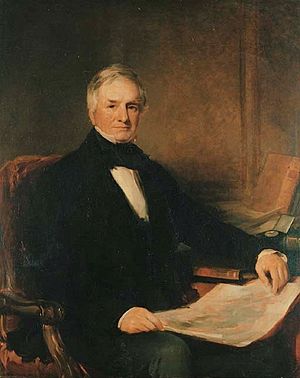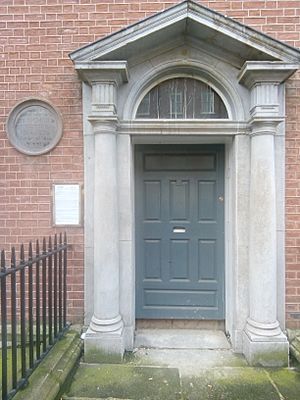Sir Richard Griffith, 1st Baronet facts for kids
Quick facts for kids
Sir Richard Griffith, 1st Baronet
|
|
|---|---|

Portrait of Sir Richard Griffith, 1st Baronet painted by Stephen Catterson Smith
|
|
| Born | 20 September 1784 |
| Died | 22 September 1878 (aged 94) Dublin, Ireland
|
| Nationality | Irish |
| Awards | Wollaston medal (1854) |
| Scientific career | |
| Fields | geology |
Sir Richard John Griffith (born September 20, 1784 – died September 22, 1878) was an important Irish scientist. He was a geologist, which means he studied the Earth's rocks and soil. He was also a mining engineer, helping to find and dig up valuable minerals.
Sir Richard Griffith is famous for two big things. He created the very first complete geological map of Ireland. This map showed all the different types of rocks and land across the country. He also wrote the "valuation of Ireland," which was a huge survey of land and property values. This survey is still known as Griffith's Valuation.
Contents
Who Was Richard Griffith?
Richard Griffith was born in Dublin, Ireland, on September 20, 1784. His father, also named Richard Griffith, was a politician. His grandmother, Elizabeth Griffith, was a well-known writer and actress.
Richard went to school in different places in Ireland, including Portarlington. He even studied in Edinburgh, Scotland.
Early Career and Studies
In 1799, when he was just 15, Richard joined the Royal Irish Artillery. This was a military group. However, he left a year later to focus on engineering and mining.
He spent two years in London studying chemistry, minerals, and mining. He learned from a famous chemist named William Nicholson. After that, he traveled around England, Wales, and Scotland to see different mining areas.
While in Cornwall, he made an exciting discovery. He found valuable nickel and cobalt ores in rocks that others had thrown away. He then finished his studies in Edinburgh. In 1807, he became a member of the Royal Society of Edinburgh. The next year, he joined the new Geological Society of London. Soon after, he returned to Ireland.
Mapping Ireland's Land
In 1809, Richard Griffith was asked to study the bogs (wetlands) in Ireland. He had to figure out how big they were and how they could be improved.
In 1812, he became a professor of geology and mining engineering at the Royal Dublin Society. He soon announced his plan to create a geological map of Ireland. Over the next few years, he surveyed many areas. He wrote reports on mineral deposits. These reports helped him create his first geological map of Ireland in 1815. He also became the government's inspector of mines in Ireland.
Building Roads and Valuing Property
From 1822 to 1830, Richard worked as an engineer for public projects in Cork, Kerry, and Limerick. He was busy fixing old roads and building many new ones. Some of these new roads were in very difficult parts of the country.
In 1825, the government asked him to survey the boundaries of Ireland. This meant marking the edges of every county, area (barony), church district (civil parish), and small village (townland). This was to prepare for the first official map of Ireland, called the Ordnance Survey.
He also helped create a law for a general valuation of Ireland. This law passed in 1826. Richard was made the Commissioner of Valuation in 1827. He started this huge task in 1830, using the new maps from the Ordnance Survey. He continued this work until 1868. His "Griffith's Valuation" was used to set local taxes and public fees.
Later Life and Recognition
Richard Griffith used all his research to improve his geological map. He published a second edition in 1835. A third, larger map came out in 1839. He updated it again in 1855. For all his hard work and contributions to science, he received the Wollaston Medal in 1854. This is a very important award for geologists.
In 1850, he became the chairman of the Irish Board of Works. In 1858, he was given the title of Baronet, which is a special honor.
Sir Richard Griffith passed away in Dublin on September 22, 1878, when he was 94 years old. He was buried with his wife, Maria Jane, in Mount Jerome Cemetery in Dublin.
Family Life
In 1812, Richard Griffith married Maria Jane Waldie. They had one son, Sir George Richard Waldie-Griffith.
Images for kids




